Psychology Essay: Altruism, Blood Donation, and Behavioral Change
VerifiedAdded on 2022/08/18
|5
|912
|10
Essay
AI Summary
This essay delves into the concept of altruism, specifically examining its application to blood donation practices in Canada. The paper identifies several psychological mechanisms, including reciprocity norms, social responsibility, kinship, and observational learning, as potential drivers for increasing altruistic behavior. It highlights the low blood donation rates in Canada and proposes interventions such as targeted advertising campaigns emphasizing the benefits of blood donation and minimizing the stigma associated with the process. Furthermore, the essay discusses the role of external motivations like rewards and money in encouraging blood donation. The conclusion underscores the importance of empathy-driven campaigns to overcome challenges like time constraints and fears surrounding blood donation, ultimately aiming to foster a culture of increased altruistic behavior and improve blood donation rates.
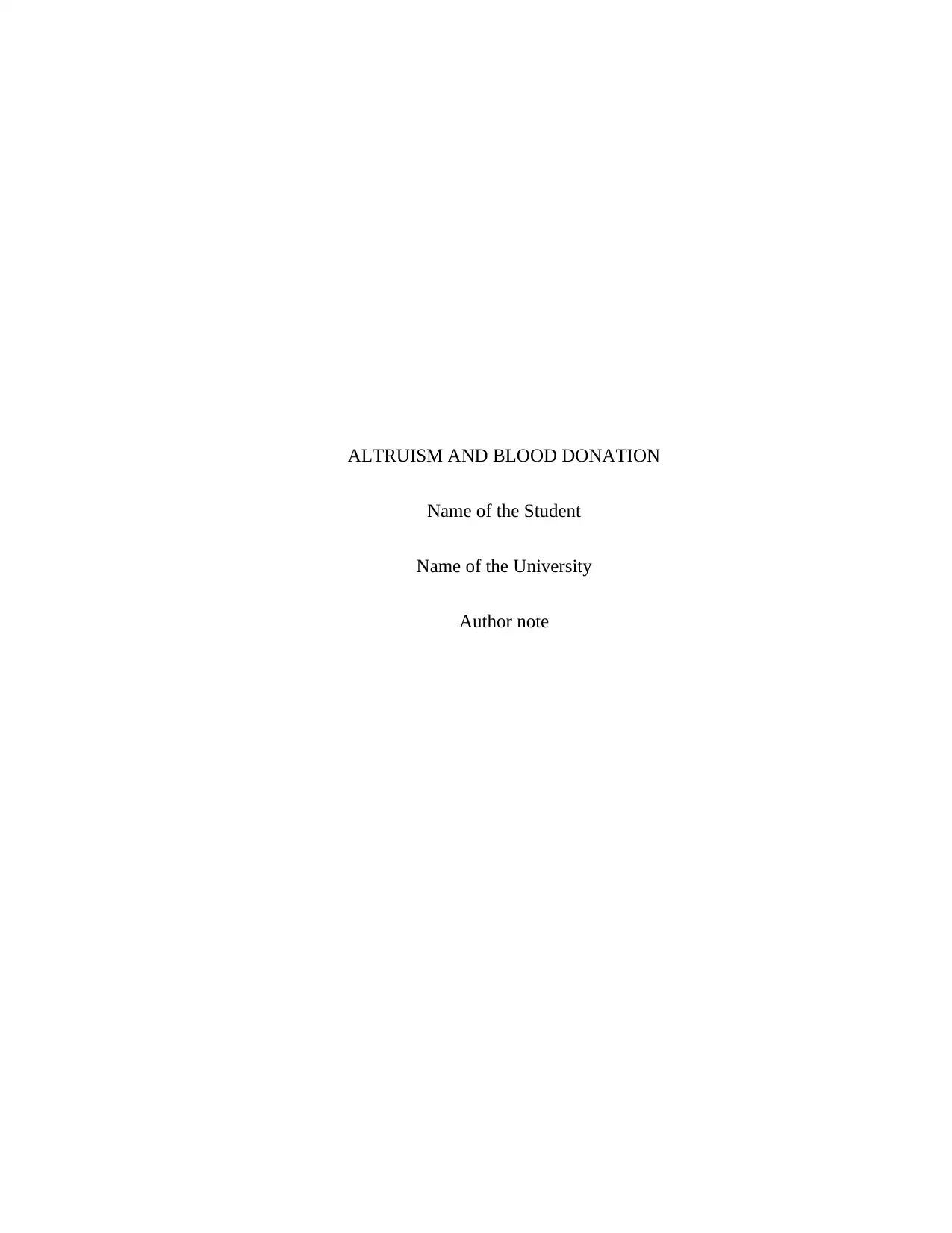
ALTRUISM AND BLOOD DONATION
Name of the Student
Name of the University
Author note
Name of the Student
Name of the University
Author note
Paraphrase This Document
Need a fresh take? Get an instant paraphrase of this document with our AI Paraphraser
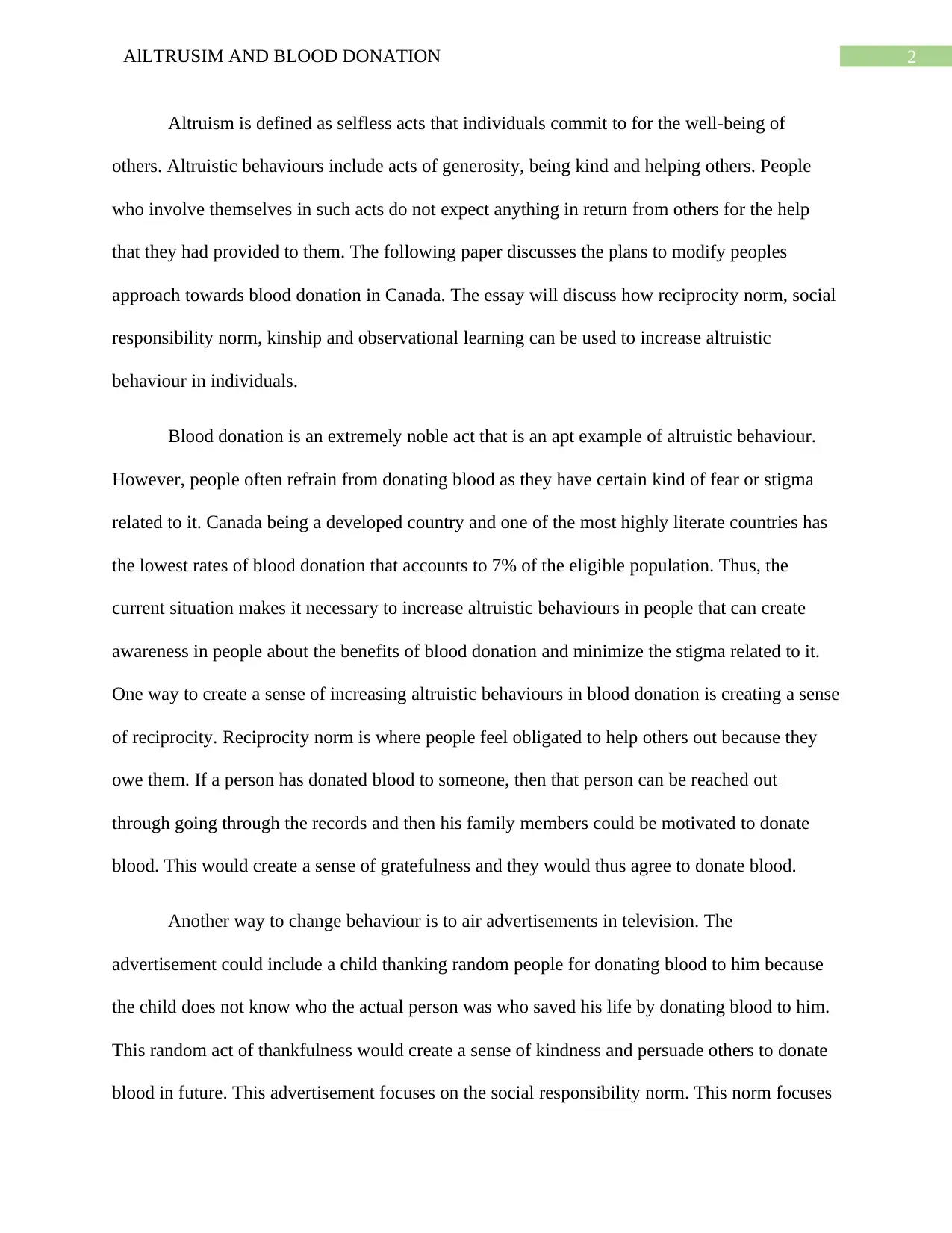
2AlLTRUSIM AND BLOOD DONATION
Altruism is defined as selfless acts that individuals commit to for the well-being of
others. Altruistic behaviours include acts of generosity, being kind and helping others. People
who involve themselves in such acts do not expect anything in return from others for the help
that they had provided to them. The following paper discusses the plans to modify peoples
approach towards blood donation in Canada. The essay will discuss how reciprocity norm, social
responsibility norm, kinship and observational learning can be used to increase altruistic
behaviour in individuals.
Blood donation is an extremely noble act that is an apt example of altruistic behaviour.
However, people often refrain from donating blood as they have certain kind of fear or stigma
related to it. Canada being a developed country and one of the most highly literate countries has
the lowest rates of blood donation that accounts to 7% of the eligible population. Thus, the
current situation makes it necessary to increase altruistic behaviours in people that can create
awareness in people about the benefits of blood donation and minimize the stigma related to it.
One way to create a sense of increasing altruistic behaviours in blood donation is creating a sense
of reciprocity. Reciprocity norm is where people feel obligated to help others out because they
owe them. If a person has donated blood to someone, then that person can be reached out
through going through the records and then his family members could be motivated to donate
blood. This would create a sense of gratefulness and they would thus agree to donate blood.
Another way to change behaviour is to air advertisements in television. The
advertisement could include a child thanking random people for donating blood to him because
the child does not know who the actual person was who saved his life by donating blood to him.
This random act of thankfulness would create a sense of kindness and persuade others to donate
blood in future. This advertisement focuses on the social responsibility norm. This norm focuses
Altruism is defined as selfless acts that individuals commit to for the well-being of
others. Altruistic behaviours include acts of generosity, being kind and helping others. People
who involve themselves in such acts do not expect anything in return from others for the help
that they had provided to them. The following paper discusses the plans to modify peoples
approach towards blood donation in Canada. The essay will discuss how reciprocity norm, social
responsibility norm, kinship and observational learning can be used to increase altruistic
behaviour in individuals.
Blood donation is an extremely noble act that is an apt example of altruistic behaviour.
However, people often refrain from donating blood as they have certain kind of fear or stigma
related to it. Canada being a developed country and one of the most highly literate countries has
the lowest rates of blood donation that accounts to 7% of the eligible population. Thus, the
current situation makes it necessary to increase altruistic behaviours in people that can create
awareness in people about the benefits of blood donation and minimize the stigma related to it.
One way to create a sense of increasing altruistic behaviours in blood donation is creating a sense
of reciprocity. Reciprocity norm is where people feel obligated to help others out because they
owe them. If a person has donated blood to someone, then that person can be reached out
through going through the records and then his family members could be motivated to donate
blood. This would create a sense of gratefulness and they would thus agree to donate blood.
Another way to change behaviour is to air advertisements in television. The
advertisement could include a child thanking random people for donating blood to him because
the child does not know who the actual person was who saved his life by donating blood to him.
This random act of thankfulness would create a sense of kindness and persuade others to donate
blood in future. This advertisement focuses on the social responsibility norm. This norm focuses
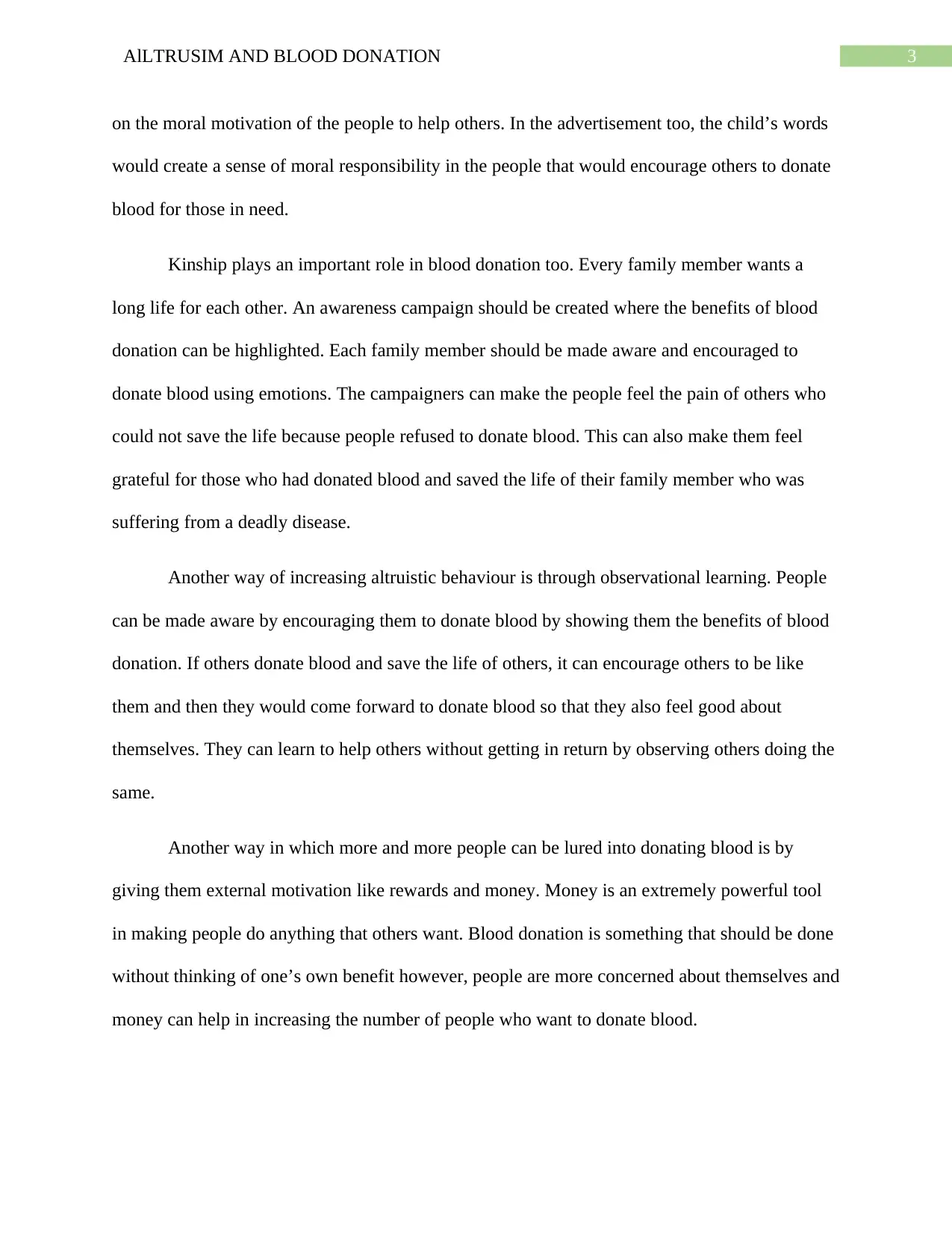
3AlLTRUSIM AND BLOOD DONATION
on the moral motivation of the people to help others. In the advertisement too, the child’s words
would create a sense of moral responsibility in the people that would encourage others to donate
blood for those in need.
Kinship plays an important role in blood donation too. Every family member wants a
long life for each other. An awareness campaign should be created where the benefits of blood
donation can be highlighted. Each family member should be made aware and encouraged to
donate blood using emotions. The campaigners can make the people feel the pain of others who
could not save the life because people refused to donate blood. This can also make them feel
grateful for those who had donated blood and saved the life of their family member who was
suffering from a deadly disease.
Another way of increasing altruistic behaviour is through observational learning. People
can be made aware by encouraging them to donate blood by showing them the benefits of blood
donation. If others donate blood and save the life of others, it can encourage others to be like
them and then they would come forward to donate blood so that they also feel good about
themselves. They can learn to help others without getting in return by observing others doing the
same.
Another way in which more and more people can be lured into donating blood is by
giving them external motivation like rewards and money. Money is an extremely powerful tool
in making people do anything that others want. Blood donation is something that should be done
without thinking of one’s own benefit however, people are more concerned about themselves and
money can help in increasing the number of people who want to donate blood.
on the moral motivation of the people to help others. In the advertisement too, the child’s words
would create a sense of moral responsibility in the people that would encourage others to donate
blood for those in need.
Kinship plays an important role in blood donation too. Every family member wants a
long life for each other. An awareness campaign should be created where the benefits of blood
donation can be highlighted. Each family member should be made aware and encouraged to
donate blood using emotions. The campaigners can make the people feel the pain of others who
could not save the life because people refused to donate blood. This can also make them feel
grateful for those who had donated blood and saved the life of their family member who was
suffering from a deadly disease.
Another way of increasing altruistic behaviour is through observational learning. People
can be made aware by encouraging them to donate blood by showing them the benefits of blood
donation. If others donate blood and save the life of others, it can encourage others to be like
them and then they would come forward to donate blood so that they also feel good about
themselves. They can learn to help others without getting in return by observing others doing the
same.
Another way in which more and more people can be lured into donating blood is by
giving them external motivation like rewards and money. Money is an extremely powerful tool
in making people do anything that others want. Blood donation is something that should be done
without thinking of one’s own benefit however, people are more concerned about themselves and
money can help in increasing the number of people who want to donate blood.
⊘ This is a preview!⊘
Do you want full access?
Subscribe today to unlock all pages.

Trusted by 1+ million students worldwide
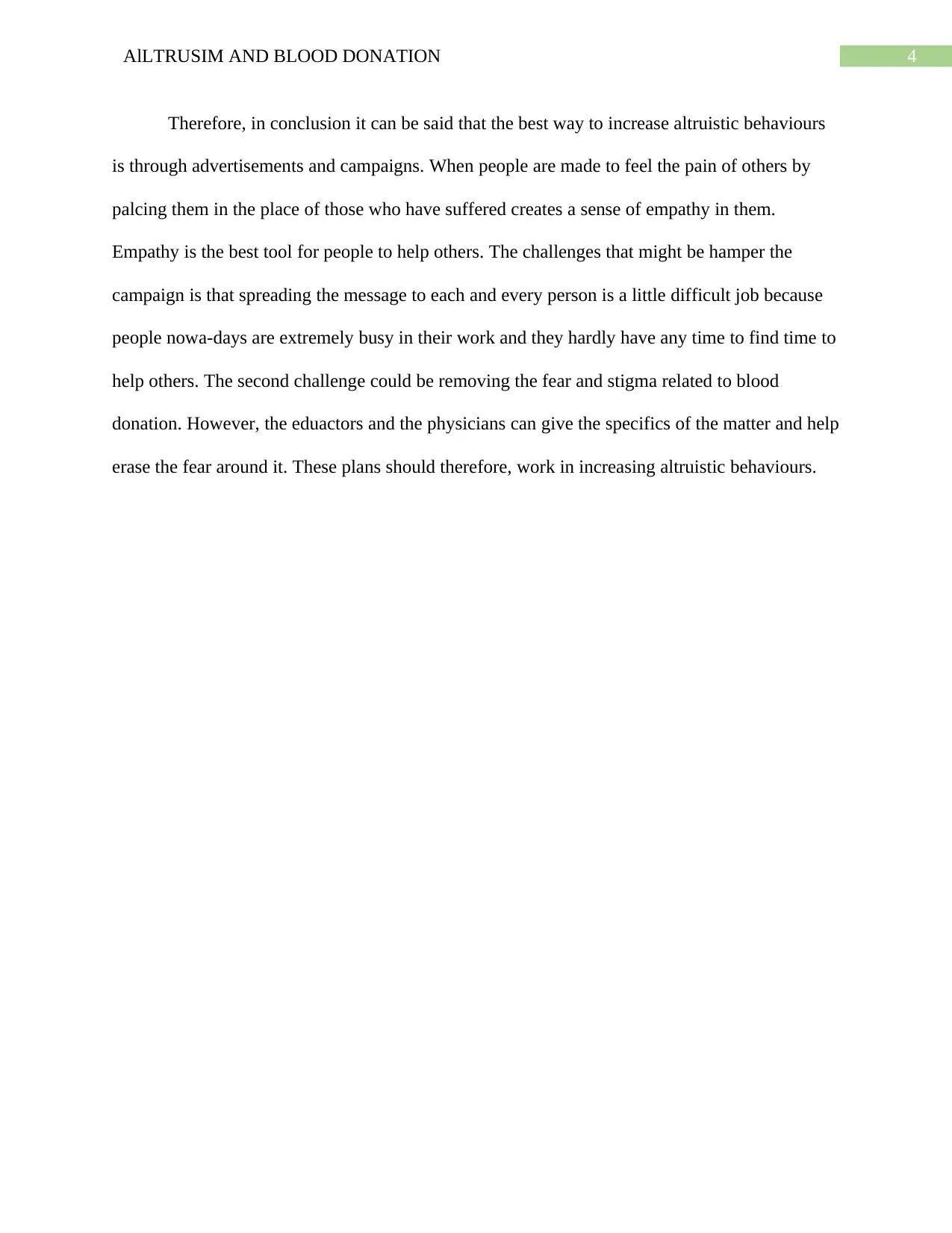
4AlLTRUSIM AND BLOOD DONATION
Therefore, in conclusion it can be said that the best way to increase altruistic behaviours
is through advertisements and campaigns. When people are made to feel the pain of others by
palcing them in the place of those who have suffered creates a sense of empathy in them.
Empathy is the best tool for people to help others. The challenges that might be hamper the
campaign is that spreading the message to each and every person is a little difficult job because
people nowa-days are extremely busy in their work and they hardly have any time to find time to
help others. The second challenge could be removing the fear and stigma related to blood
donation. However, the eduactors and the physicians can give the specifics of the matter and help
erase the fear around it. These plans should therefore, work in increasing altruistic behaviours.
Therefore, in conclusion it can be said that the best way to increase altruistic behaviours
is through advertisements and campaigns. When people are made to feel the pain of others by
palcing them in the place of those who have suffered creates a sense of empathy in them.
Empathy is the best tool for people to help others. The challenges that might be hamper the
campaign is that spreading the message to each and every person is a little difficult job because
people nowa-days are extremely busy in their work and they hardly have any time to find time to
help others. The second challenge could be removing the fear and stigma related to blood
donation. However, the eduactors and the physicians can give the specifics of the matter and help
erase the fear around it. These plans should therefore, work in increasing altruistic behaviours.
Paraphrase This Document
Need a fresh take? Get an instant paraphrase of this document with our AI Paraphraser
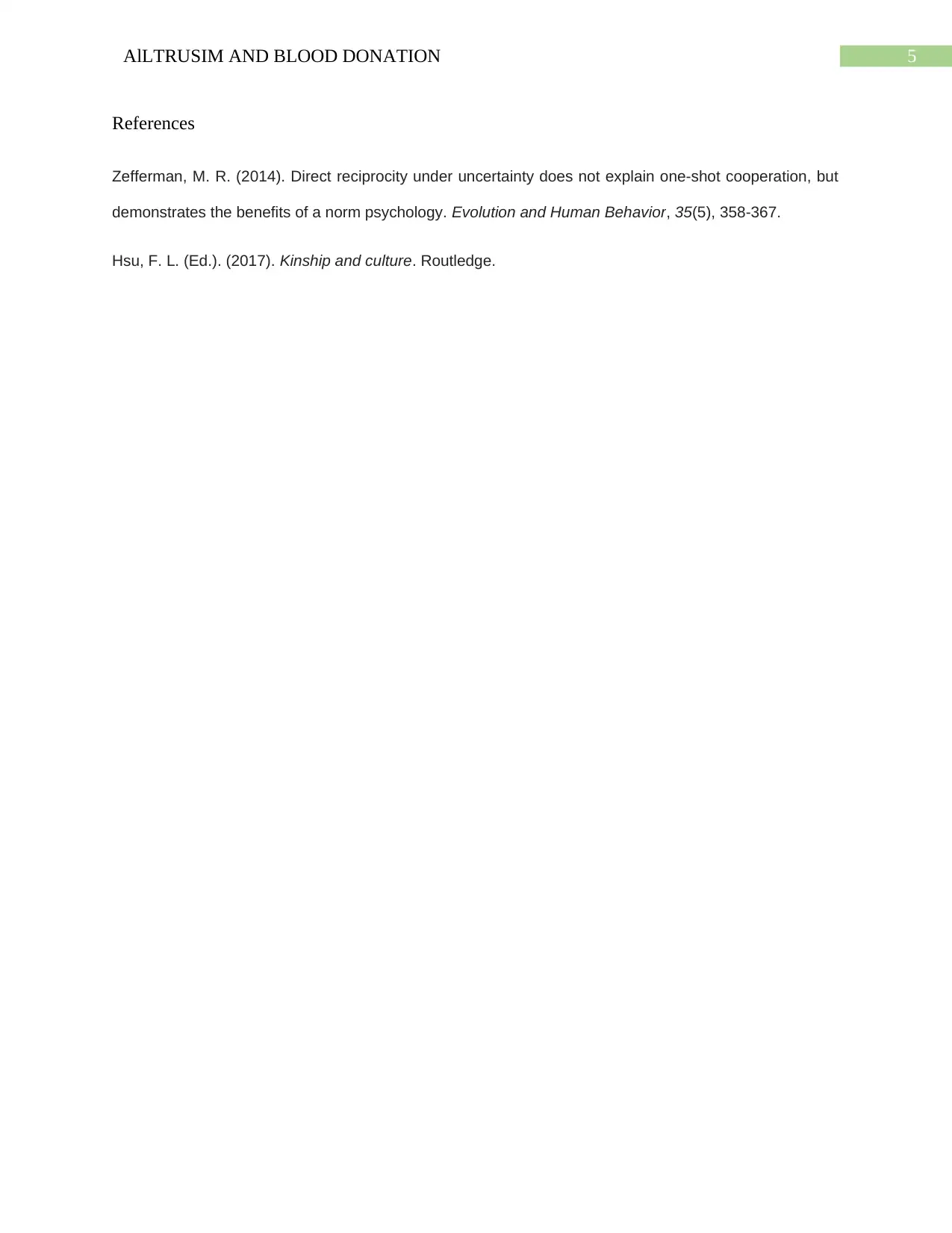
5AlLTRUSIM AND BLOOD DONATION
References
Zefferman, M. R. (2014). Direct reciprocity under uncertainty does not explain one-shot cooperation, but
demonstrates the benefits of a norm psychology. Evolution and Human Behavior, 35(5), 358-367.
Hsu, F. L. (Ed.). (2017). Kinship and culture. Routledge.
References
Zefferman, M. R. (2014). Direct reciprocity under uncertainty does not explain one-shot cooperation, but
demonstrates the benefits of a norm psychology. Evolution and Human Behavior, 35(5), 358-367.
Hsu, F. L. (Ed.). (2017). Kinship and culture. Routledge.
1 out of 5
Related Documents
Your All-in-One AI-Powered Toolkit for Academic Success.
+13062052269
info@desklib.com
Available 24*7 on WhatsApp / Email
![[object Object]](/_next/static/media/star-bottom.7253800d.svg)
Unlock your academic potential
Copyright © 2020–2025 A2Z Services. All Rights Reserved. Developed and managed by ZUCOL.




